Writing productivity tools and apps make it easier to structure your work and maximize what you get out of available writing hours. Here are 7 tools and apps that will help you finish a book this year:
1. Google Docs
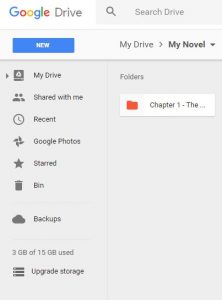
It's tricky keeping productive when you have countless other demands on your time. Google Docs is useful for multiple reasons. Not only is it a free, in-browser word processor. You can also download the app for your phone and access your scene or chapter drafts when you're on the go. Stuck in line? Get out your phone and resume drafting in Docs while you wait.
You can even plan and outlines stories using Docs.
You can organise your Google Docs documents in folders in Google Drive. This you can access either from within your Gmail account or by navigating directly to Google Drive and signing in. Create a folder per chapter, and keep the outline and draft for each chapter in its own, named folder. This makes it easy to keep a global view of your work-in-progress.
2. Evernote
It slows down productivity if you have to stop to try find an article you read once that was relevant to your story. Enter Evernote: This handy app lets you save full articles or quotes into Evernote for later viewing. Because you can write and organise notes, you can also use Evernote to structure your draft and stay focused.
The basic version of Evernote is free, but the premium version offers a host of additional features. There's an in-depth post here by a staff writer for Evernote on using the app to organise your writing.
3. Scrivener
Scrivener by Literature and Latte is a useful writing app for Microsoft Windows, macOS and iOS that also makes it easier to structure your writing and plan your research.
One of Scrivener's best features is the storyboarding virtual corkboard. Here you can arrange virtual index cards, rearranging and shuffling snippets of text visually. Incidentally, this is how the celebrated author Vladimir Nabokov wrote his novels. Nabokov wrote his best-known novels (such as Lolita) entirely on index cards.
4. Now Novel
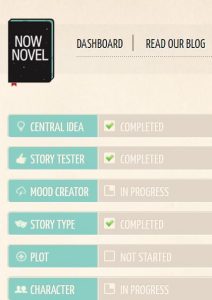
We're being cheeky and including Now Novel because we founded it with the express purpose of helping aspiring writers get and stay productive.
Working out the individual elements of your novel (such as its cast of characters, your themes and major plot points) is challenging. We put together the Idea Finder, a structured series of prompts organised by theme, to help you build your story's blueprint. Use it to keep building your story premise until it can sustain a fleshed out story.
To keep productive this year, try to write at least 1 section of your draft per week. In your 'Scribble Pad' on Now Novel, you can save sections of your draft to your private member profile and share any you choose with the rest of the community for helpful feedback.
5. Trello
If your writing productivity flounders because you don't have structure, Trello is a useful free productivity app. Although it is not designed expressly for writing a novel, its corkboard-like structure makes it excellent for this.
In Trello, you can create a board and name it with your novel's working title. From here, you can create titled lists and add or 'pin' movable cards (similar to index cards) to each list. For example, you can create a list per chapter and a card summarizing each scene in your chapter, like this:
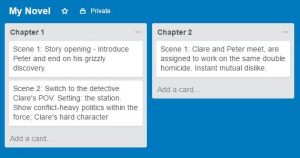
Another way you can use lists and cards on Trello is to organize research so you can quickly find information relevant to your story. For example, you can create a list per setting, fleshing out with place names or descriptive details:

Staying organised will help you to progress smoothly from scene to scene as you draft.
6. A distraction-free writing environment
Most full-featured word processors such as Microsoft Word now have minimalist full-screen modes that let you write distraction-free. There are many good browser-based options, too. A low-distraction writing environment can really help you to stay productive for longer.
We haven't listed a single option here as there are many good ones. Try ZenPen, for example, a simple browser-based writing app that consists simply of a white background with a bold heading you can edit and minimal text markup features. From ZenPen you can copy and paste drafts into your favourite word processor for revision and storage. ZenPen also lets you save your writing in HTML or plain text formats - useful if you plan to put together an eBook.
Calmly Writer is another minimalist distraction-free online writing app.
A tip: If you tend to go back and edit what you've written while drafting before you've completed a section, change your text colour in your regular word processor to white. That way you won't see what you've just written until you highlight your text and change it back to your standard colour.
7. A web-based timer
A timer is an essential tool for boosting your writing productivity. When you track how you spend your writing sessions, you become conscious of productive versus unproductive sessions. You can also portion out writing time and breaks better so that you avoid burnout. Working for 20 minutes at a time with 10 minute breaks between stretches is one way to approach this.
There are several web-based timers you can leave running in the background. If you simply Google 'Timer', you can use Google's no-frills timer and stopwatch. Leave audio notification on and your timer will beep when it's time for a break.
Additional useful tools
Besides apps to bolster your productivity, there are many other useful online tools for authors. It's easy to create professional designs for your social media accounts or author blog using Canva. This online design tool includes useful templates with the correct dimensions for all the major social platforms, as well as an abundance of free and stock photos, illustrations and fonts. It's a simple drag-and-drop editor that makes it easy to create glossy promotional materials.
Hemingway App is another useful tool not in the productivity sphere. Use this free text checker to find unnecessarily complex words you can replace with simpler ones, to spot and remove weakening passive voice, and more.
Milanote is another versatile and flexible tool for brainstorming, saving story research and more. Clip articles into an organized system for retrieving factual information to use in your story, or use one of the many templates offered to structure your process.
VEED.IO is a browser-based voice-recording app and video editor you can use for speech to text or for creating video content for your author page.
Dividing your writing time and your novel itself into manageable parts is core to staying productive and building a publishable manuscript, scene by scene. Join Now Novel for constructive feedback or work with a writing coach to make smoother, easier progress.



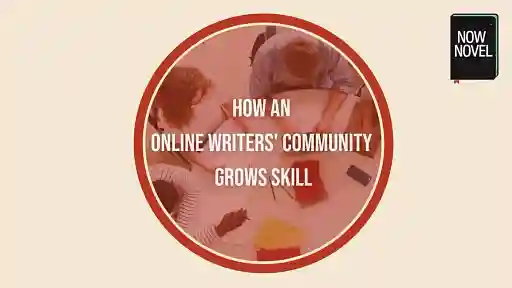
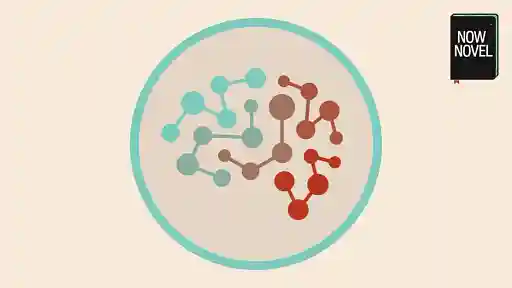
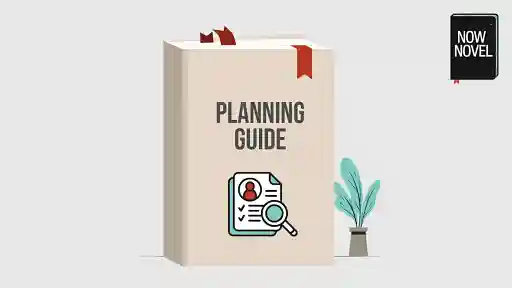
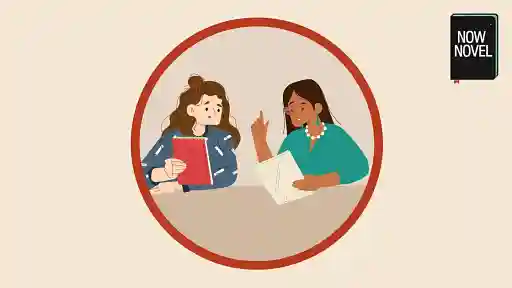
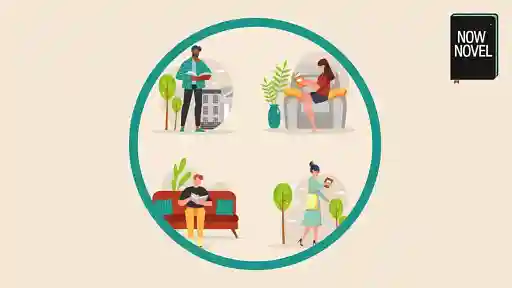


What a fabulous list! Do you know if any of these have the corkboard and index card feature like Scrivner? I'd love to find a free app that works similar. Of course, that might be a big ask. :-)
Sue Coletta - Over 9 years ago
Thanks, Sue! I can't remember off-hand, but www.trello.com is a free to-do/time-management tool that has a list interface similar to the corkboard (you can create individual lists with any heading you can think of and add 'cards' arranged in any order to each list. You can drag lists around in the window to reorder as well as reordering cards vertically. Using it did make me think of something I'd read about Nabokov having written all his novels on index cards.
Bridget At Now Novel - Over 9 years ago
That would be me...the writer who still uses index cards. :-) Do you mind if I pick your brain on something else? Lately, I've been thinking that a self-hosted site is the way to go. Then this morning I woke to find all my customization--hours of CSS work--erased from my site. Nightmare! No idea why; others are having this problem too. I've finally got it under control, but Wordpress.com is famous for making "improvements" that cause problems. My question is: is it difficult to make the switch to self-hosted? Would I lose my audience? My debut is slated for pre-release in Sept., and I don't want to make the wrong move. I'm asking you because I respect you and the work you do here. I'd also love it if you'd grant permission to add your site to my Crime Writer's Resource. I always like to ask before adding a link.
Sue Coletta - Over 9 years ago
I think it sounds like a great technique for writing a book, I really should try it myself. Self-hosted does give you a lot more liberty as far as customization goes, but it really is useful to have someone very tech-minded (preferably a developer) on hand in case of Wordpress and other niggles! Unfortunately our developer is away at the moment so I don't have the answer. Perhaps email Wordpress and your hoster to ask. Sorry I couldn't be more help on this. On the latter: Thank you, that's too kind. I'd love to be featured in your resource list.
Bridget At Now Novel - Over 9 years ago
Might be too late, but still relevant. I use Amazon's tool, studios.amazon.com , to outline my stories. Works mainly on the computer but can be used on smartphones. It's free, though targeted towards screenwriters (still great for us regular writers). Completely recommend it :)
Beachedeesas - About 9 years ago
Thank you! Sounds perfect.
Sue Coletta - About 9 years ago
My favorite productivity writing tool is old school -- a timer. I sit down for ten minutes at a time and aim to produce approximately 350 words to contribute to my work in progress. When the timer goes off, I can grab a tea, put another load of laundry in, or walk to the mailbox. Then I set the timer again. Works like a charm.
Michelle - Over 8 years ago
I like that approach, Michelle. Breaking it up into smaller, manageable tasks is the way to go. Thanks for sharing your process.
Bridget At Now Novel - Over 8 years ago
I absolutely love the program Write or Die. It has may unique settings well above and beyond its base of timer driven distraction free writing. It has fun consequence and stimulus modes that can gently push you along, or make you want to die. I rec it to all my writing friends.
Angela Kulig - About 8 years ago
Hi Angela - thank you for sharing that, I'll have a look. Perhaps will come in handy for future updates. Thanks!
Bridget At Now Novel - About 8 years ago
I use that for writing prompts. It's a great tool to make you think quickly so when working on work outside of write or die you'll have an easier time with the flow. I was introduced to it a year ago and I still love it!!
Ashley Renee Sherin - Over 7 years ago
Pearl Harbor was bombed and the U.S.S. Arizona was sunk a year-and-a-half before I was born. My first writing instruments were No. 2 lead pencils and Big Chief Tablets--if you don't count the purpose crayon marks on the wall of my room. So, much of what are called productivity tools are what I am forced to call distractions. Being computer literate is a blessing. Trying to go beyond that is, for a 73-year-old one-time member of Den One, Pack 25 at Osborn School, a trial and, sometimes, a tribulation. So I have quit trying to learn the new applications, productivity tools, or other state-of-the-art things designed by creative folk to push me to be a better, faster, sweeter, less-cantankerous writer. If Miss Attaway, Miss Miller, Mrs. Corbitt, and Mrs. Wynn didn't teach it to me back then in the era of diving under desks to get away from the A-Bomb that might detonate directly over our school, then I doubt I'm ever going to learn it. Thanks, folks, for wanting to make me better. But it looks as if the Big Chief himself has still got the job.
Jim Porter - About 8 years ago
Jim, thank you for your contrary perspective. That's a very good point that these tools can trip you up as much as help you - it's why it's important to choose carefully (or not choose at all if analogue suits you better).
Bridget At Now Novel - About 8 years ago
You guys need an app that would be fantastic maybe someday?
Mandy - About 8 years ago
Hi Mandy - we'd definitely love to have an app. It's really a question of the queue of tasks our developers already have lined up, but hopefully we'll get there in the near future - it would be fun to have.
Bridget At Now Novel - About 8 years ago
I understand it just be extra helpful for those writers that have health issues some of us depend heavily on apps and anything that can make it easier to keep writing even with having health issues. I have many myself and still keep trying to write. I use google docs a lot now I am really in love with that especially since you can use it on your phone. I know for a fact since I run a writing group that there are other writers with health issues and just know that having an app would be useful for them probably too.
Mandy - About 8 years ago
I'm in love with Evernote. Also, I integrated it with my todo/calendar app (focuster.com), so now my notes are landing as tasks on my todo list which makes it much harder to miss anything important.
Casey Smith - About 8 years ago
Thanks for the suggestion of additional ways to organize your process, Casey.
Bridget At Now Novel - About 8 years ago
Give me good coffee with almond milk, internet connection, and the writing work will flow as a swan on a river on a hot summer day. Today’s digital treasures brake all the barriers of procrastinations, they annihilate even a shadow of creative stress, and the only thing writers should do is just start writing, even if the text remind the chaotic chain of words, it’s always better than nothing. Being a pedant to the highest extend, I pay much attention to the originality of my texts. Well, unintentional plagiarism isn’t a pleasant thing, indeed. That’s why I prefer to use Unplag, there’s also a free version https://unplag.com/free-plagiarism-checker/, but it’s limited (user is given 500 words per one check). All in all, all the tools are cool. They make writing process a journey full of pleasure.
Ashley Benson - About 8 years ago
Thanks for great post!
Janey - Almost 8 years ago
I haven't tried those tools yet, they are actually new for me. But I definitely do try cause I like something up-to-date. I used to utilized my favorite tool for plagiarism detection PlagiarismSearch. The thing is it can operate with all text formats, and that's the most attractive for me. Thanks a lot for giving us this essential list.
Monica Seims - Almost 8 years ago
Great list. I'd like to include ProofHub in your list of productivity. It is web based project management software that help you to plan, collaborate, organize and deliver projects of all sizes. Its unique and enterprising features like discussions, task lists, to-dos, calendars, dashboard, timesheets and customization allow a manager to prioritize, schedule and execute tasks and activities. It grants stability to the project and makes it well structured. Accountability for various tasks and events can be clearly established and tracked effectively.
Sharon Thomson - Over 7 years ago
Great article! Thank you for this useful information.
Namwham - Over 7 years ago
Great list. I'd like to add IndyDesk to the list of productivity tools. For project execution on its time and to check each activity on every single task, one can follow a PM (Project Management) tool to boost up the productivity. I’d like to recommend Indydesk for it. It allows to create number of tasks, assign tasks to your team members and organize your to-do list to suit your needs at one place. One can easily manage projects, schedule, discuss, work and communicate with your team members.
Samantha - Almost 7 years ago
Thanks for preparing a list of helpful apps. As a writer, I often get to the point when I need to use additional tools to keep productive. Google Docs, of course, is my number one tool. Another tool I always use is Evernote. It works perfectly well for me when it comes to notetaking, and organize my notes. As for time trackers, I like Rescue Time. Not only it tracks how much time I spend writing, but it also helps to analyze and eliminate distractions. These are the most useful ones for me personally, but of course, there's a lot more https://ivypanda.com/blog/best-writing-tools-and-resources/. I've never heard of Hemingwayapp, but I'm gonna give it a try.
James Corbyn - Almost 5 years ago
I use kanbantool.com to manage my tasks, I think it works better than Trello. It's definitely less confusing. And it has a time tracking feature, so I can easily check how much time I spend on each task.
Dorothy - Over 4 years ago
I personally blog, and in my experience, people reaching out to me in an open, honest way, clearly detailing their intentions, and making a request is the most effective way to get results. I blog and can honestly say being clear and direct catches my attention.
Gaven - Over 4 years ago
good
Nathan Kermod - Almost 4 years ago